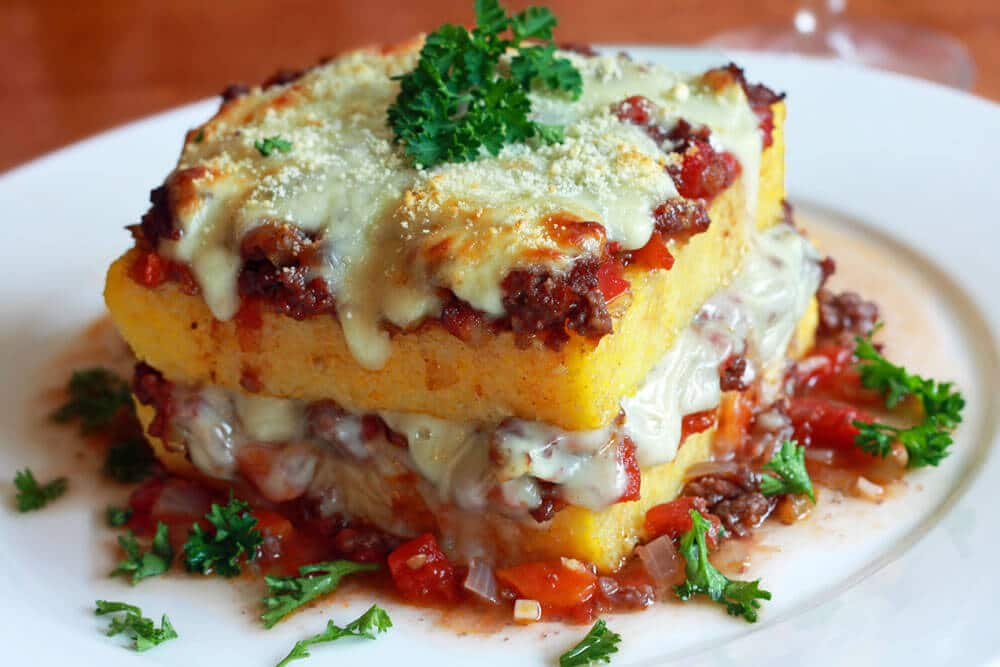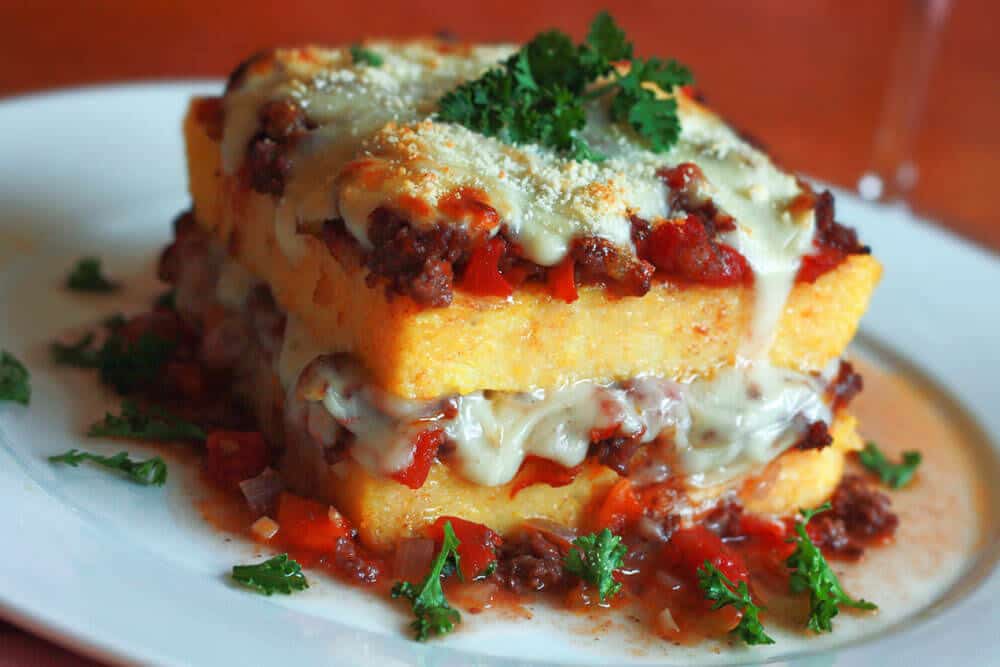Polenta Lasagna
This post may contain affiliate links. See my disclosure policy.
From the Campania region of Southern Italy, this traditional Polenta Lasagna recipe is as beautiful as it is delicious and captures all the charm of rustic Italian cuisine! It’s true Italian comfort food and the sauce tastes even better if it’s made in advance. The polenta can likewise be made in advance so all you have to do is assemble and bake.

Polenta Lasagna Recipe
Polenta Pasticciata con Ragu di Carne, a dish from the Campania region of southern Italy. This is a polenta casserole with a typical Italian ragu di carne. Polenta is made of coarse yellow cornmeal slowly cooked in water or stock until the desired consistency is met. While polenta is more often served soft and creamy, the polenta in this dish is cooked for 30-40 minutes and left to firm up until it is firm and can be sliced. .
Polenta isn’t very commonly known or eaten in the U.S.. It’s still mostly eaten in Italy. Polenta has been around since Roman times and was originally a peasant food. Before corn was introduced to Europe from the New World in the 16th century, polenta was made with other starchy ingredients such as millet, spelt, farro, chickpeas and chestnut flour. And though traditionally a poor man’s food, polenta is considered fine dining in the U.S. and is commonly served in more upscale restaurants.
This Polenta “Lasagna” is Italian comfort food at its finest. Beautiful in presentation and delicious to the taste!

For more traditional Italian dishes be sure to try my:
- Osso Buco
- Italian Pork Ribs
- Chicken Cacciatore
- Braciole
- Bolognese Sauce
- Beef Ragu
- Pasta alla Norma
- Chicken Marsala
- Chicken Piccata
Save This Recipe

Polenta Lasagna
Ingredients
- For the Polenta:
- 8 cups chicken broth
- 2 cups coarsely ground yellow cornmeal
- 1 tablespoon salt
- For the Sauce:
- 2 tablespoons unsalted butter
- 2 tablespoons extra virgin olive oil
- 1 yellow onion , diced
- 1 carrot , diced
- 1 celery stalk , diced
- 2 cloves garlic , minced
- 1/2 teaspoon dried thyme
- 1/2 teaspoon dried rosemary
- 1/4 teaspoon ground sage
- 1 bay leaf
- 1/2 lb ground beef
- 1/2 cup dry red wine
- 30 ounce canned petite diced tomatoes , do not drain
- salt and pepper to taste
- 1/2 lb fresh mozzarella cheese , sliced, or 2 cups grated mozzarella cheese
- 1/2 cup grated Parmesan-Reggiano cheese
Instructions
- To make the polenta: In a large saucepan, bring the chicken stock to a boil. Slowly add the cornmeal in a thin, steady stream while whisking constantly to prevent lumps, then add the salt. When the polenta begins to bubble, reduce the heat to low and continue to cook, whisking steadily, until the mixture is thick and pulls away from the pot, 15-20 minutes.Oil two 8-inch square baking pans and pour the polenta into them, dividing equally. Use a rubber spatula moistened with water to spread the mixture and flatten it evenly. Once it has cooled, place it in the refrigerator until firm, at least one hour. The polenta can be made a day in advance and kept in the fridge covered with plastic wrap.
- In the meantime, to make the sauce, melt the butter and olive oil in a large saucepan or Dutch over medium heat. Add the onion, carrot and celery and saute until tender, about 10 minutes. Add the garlic and cook for another minute. Add the ground beef and stir to break up any lumps. Cook for 10 minutes until the beef is browned and no pink is remaining. Add the wine and bring to a rapid boil for 2 minutes. Add the tomatoes, herbs, bay leaf, and salt and pepper to taste. Return the sauce to a boil, reduce the heat to low and let simmer, uncovered for 45 minutes until the sauce is slightly thickened.
- Preheat the oven to 400 F. Grease a large rectangle baking dish.Cut the polenta into eight 4-inch squares and place half of the squares in the bottom of the rectangle baking dish. Spoon half of the sauce evenly over the polenta squares and top with half of the mozzarella and half of the Parmesan-Reggiano. Arrange the remaining 4 polenta squares on top and cover with the remaining sauce, mozzarella and Parmesan-Reggiano cheeses.Bake for about 40 minutes, or until the cheese melts and the sauce is bubbling. Let the casserole stand for 5 minutes before serving.
Nutrition
Originally published on The Daring Gourmet February 18, 2013



















I made a version of this the other night. Just a tip – it’s actually pretty quick meal if you already have the polenta made. We had polenta with a turkey stew one night and I made a double batch, poured the leftovers onto a baking sheet to cool and harden, and then sliced them up, stuck them in the fridge until the end of the week when I made this. I already had meat sauce in the freezer, so voila!
Thanks for the feedback, Heather! It is quick indeed. I think I make a note of that in my post that this dish lends itself perfectly to a make-ahead meal. And it looks like the kind of meal you’ve spent hours on! ;)
Love your recipes. I know this site is all about traditional Italian recipes, but I just wanted to let you know that this lasagna recipe worked out wonderfully with some locally available southeast Virginia ingredients. I found your site when looking for ways to use leftover cheese grits after I cooked way too much for company. I utilized the cooled grits in the manner in which you used the polenta, and subbed ground venison for the ground beef in the sauce. It was really good, and a neat change of pace. For my next experiment I plan to recreate your braciole with venison. I have a nice roast cut from a doe that should do well. I don’t know how you feel about wild game, but I appreciate you sharing your recipes. Many of them translate well to what I have available.
That’s fantastic, chameleon! I’m thrilled to hear you enjoyed this and I’ve no doubt the venison worked beautifully. How I feel about wild game is that I wish I had access to some! :) My husband has talked about trying his hand at hunting but neither of us can muster up the courage to do it. I would bawl my eyes out and he’s too much of a softie himself. So we really wish we had some friends who hunt who were willing to share! ;) Please let us know how the braciole turns out. Happy cooking!
You stole my mother’s recipe. Thanks, now I can make it after all these years.
Has anyone made this? A tablespoon of salt? It is WAY too salty…..
Have you actually tried it, MD? 2 cups of cornmeal to 1 tablespoon of salt is pretty standard. Do a Google search and you’ll find it’s the common ratio across a variety of polenta recipes. As with any recipe though, the salt content can be tailored to your own preferences.
Thank you for posting this recipe. I have been searching for it and couldn’t remember where I had seen it last (Williams-Sonoma website years ago). Anyway, it is fabulous. I don’t bother to cut it into squares. I just layer the top piece right on the bottom one and bake it like lasagna and cut it into squares after baking. I have also tried it with smoked mozzarella which was interesting as well.
Wonderful, so glad you’ve found it, Beth! I’m pretty sure the WS version is available online and you can compare it to this one. I’ve made several alterations and am very happy with the results. Happy cooking!
Oh, also meant to tell you that I got a great deal on the Dusseldorf mustard from World Market. I had checked on Amazon and the shipping price was horrendous so I did some searching. Check them out, lots of interesting stuff!
That’s great to know, thanks for the tip, Tammi! We have a local World Market and always find some great things. We have a local German grocery store where I usually buy the mustard. I’ll need to check World Market to see if they’re cheaper ;)
We really enjoyed this Kimberly! I used a sheet pan to cool and chill the polenta, resisting the urge to add parmesan which in retrospect was a good thing as I think it would have made the polenta too salty. Have you ever frozen this? We go for our annual week in the Poconos next month and I try to make things ahead of time so that I don’t have to do much while on vacation. Oh, and I’m waiting for my Essig Essenz to arrive. Harry is quite impatient to try it, he will practically drink vinegar straight!
Fantastic!! I’m glad you enjoyed it, Tammi, and appreciate the feedback! No, I haven’t tried freezing it but polenta is supposed to freeze very well. From eHow: “Polenta freezes wonderfully and the flavor can actually improve with time. Frozen polenta is ideal for a quick lunch or dinner.” If Harry can comfortably handle drinking even a tablespoon of Essig Essenz straight then the man’s stomach is made of steel! Wow, the stuff is potent!
Have a wonderful vacation in the Poconos!
1)love this recipe 2)not to be a jerk, but…here was *no corn* in ancient Rome, folks, though they did make polenta-like things out of chestnuts and farro. Sorry, anthropology and history-minded person can’t let that slide.
Hi Jerms, no one said there was corn in ancient Rome, so no argument there. As I said in a previous comment, “Polenta dates back to ancient Roman times, was a staple in Roman cuisine, and was made with a variety of grains. When maize was introduced to Europe in the 15th-16th century, Italians started making polenta with cornmeal as well.” I can imagine that a chestnut-based polenta would taste pretty amazing! I’m glad you enjoyed this recipe, thanks. Best, Kimberly
can’t wait to make this!
Hi Julia! Let me know how it goes!
i made this for supper and i love it very much! i was trying to find an alternative to lasagna and i found this! i have to tell you it was way easier to make than a traditional lasagna! thank you for a wonderful recipe!
Annie, I’m so happy to hear that! And you’re right, it is less work than traditional lasagna. I think many people look at the picture though and feel a little intimidated by it, not taking the time to read just how simple it is to make. It looks impressive, tastes impressive, and is impressively simple! Thanks so much for your feedback!
I don’t know when the Italians started eating polenta, but since corn comes from the “New World,” it couldn’t have been before 1492.
Polenta dates back to ancient Roman times, was a staple in Roman cuisine, and was made with a variety of grains. When maize was introduced to Europe in the 15th-16th century, Italians started making polenta with cornmeal as well.
This looks seriously incredible. Pinning because I really really want to try this! I LOVE Italian food and this is looking perfectly authentic. Thanks for the post!
Thank you very much for your compliment, Jaclyn. I hope you do make it – and be sure to let me know what you think. If you love authentic Italian food, you’ll also love the Chicken Marsala, Ragu di Carne and Chicken Cacciatore (another polenta dish). Thanks for visiting – I hope you return! Happy Cooking!
This dish looks terrific. But I have a question. How can polenta have been around since Roman times if corn wasn’t introduced to Europe until the 16th century? Was it originally made from something other than corn?
Hi, you’re right, that line is confusing and I’ve added a modifier. Yes, polenta was originally made from a variety of starchy grains (eg, spelt, millet, chestnut flour, etc). The term “polenta” comes from Latin to simply refers to grains that have been crushed into a flour.
Hi Kimberly, it’s also interesting to add that the word “corn” itself is the European word tacked onto the New World grain. Europeans didn’t /couldn’t differentiate, just used the generic “corn”, which means grain kernel, by the way, for the native grains. The Romans always had polenta, it’s just become more common to have it made with MAIZE now. Great site ya got here!
This looks so insanely delicious. Just got back from Bologna- the ragu there was amazing! You haven’t lived til you’ve tried bolognese in Bologna!!
Thank you! I’m confident you’ll find that this ragu as well as the Spaghetti with Authentic Ragu di Carne (http://www.daringgourmet.com/2013/01/08/36/) is as good as what you fell in love with in Bologna. Every time I make and eat it I reminisce about my time spent in Italy. Thanks for stopping by!
I trust you! Thanks for the recipes!
Oh wow! What a yummy looking and creative lasagna. I hope you’ll consider adding this to my weekend link-up. We are featuring casseroles. -Savannah http://www.hammocktracks.com
Thanks, Savannah. I’d be honored to add it to your line-up, and thank you! How do I go about doing that? Off skiing now for the day with my hubby, but will be thrilled to add it this evening.
WOW and YUMMMMMM! I need to try something like this, I heart polenta!
Thanks for the compliment, Sophia, and for stopping by!
This looks delicious! I’m putting it on “the list.”
Thank you! So glad to have made your list and thanks for stopping by..